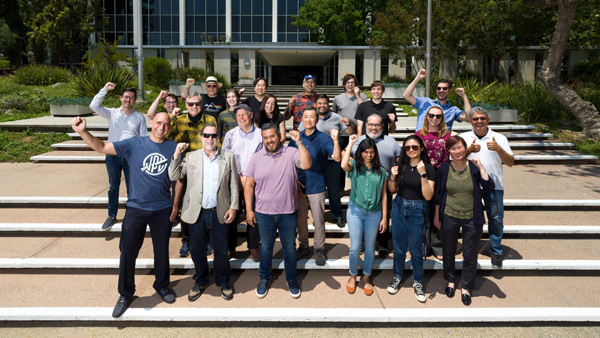
NASA / JPL - Caltech
NASA’s New Experimental Antenna Tracks Deep Space Laser (News Release)
Capable of receiving both radio frequency and optical signals, the DSN’s hybrid antenna has tracked and decoded the downlink laser from DSOC, aboard NASA’s Psyche mission.
An experimental antenna has received both radio frequency and near-infrared laser signals from NASA’s Psyche spacecraft as it travels through deep space. This shows that it’s possible for the giant dish antennas of NASA’s Deep Space Network (DSN), which communicate with spacecraft via radio waves, to be retrofitted for optical, or laser, communications.
By packing more data into transmissions, optical communication will enable new space exploration capabilities while supporting the DSN as demand on the network grows.
The 34-meter (112-foot) radio-frequency-optical-hybrid antenna, called Deep Space Station 13, has tracked the downlink laser from NASA’s Deep Space Optical Communications (DSOC) technology demonstration since November 2023. The tech demo’s flight laser transceiver is riding with the agency’s Psyche spacecraft, which launched on October 13, 2023.
The hybrid antenna is located at the DSN’s Goldstone Deep Space Communications Complex, near Barstow, California, and isn’t part of the DSOC experiment. The DSN, DSOC and Psyche are managed by NASA’s Jet Propulsion Laboratory in Southern California.
“Our hybrid antenna has been able to successfully and reliably lock onto and track the DSOC downlink since shortly after the tech demo launched,” said Amy Smith, DSN deputy manager at JPL. “It also received Psyche’s radio frequency signal, so we have demonstrated synchronous radio and optical frequency deep-space communications for the first time.”
In late 2023, the hybrid antenna downlinked data from 20 million miles (32 million kilometers) away at a rate of 15.63 megabits per second – about 40 times faster than radio frequency communications at that distance. On January 1, 2024, the antenna downlinked a team photograph (shown below) that had been uploaded to DSOC before Psyche’s launch.
Two for One
In order to detect the laser’s photons (quantum particles of light), seven ultra-precise segmented mirrors were attached to the inside of the hybrid antenna’s curved surface. Resembling the hexagonal mirrors of NASA’s James Webb Space Telescope, these segments mimic the light-collecting aperture of a 3.3-foot (1-meter) aperture telescope.
As the laser photons arrive at the antenna, each mirror reflects the photons and precisely redirects them into a high-exposure camera attached to the antenna’s subreflector suspended above the center of the dish.
The laser signal collected by the camera is then transmitted through optical fiber that feeds into a cryogenically-cooled semiconducting nanowire single photon detector. Designed and built by JPL’s Microdevices Laboratory, the detector is identical to the one used at Caltech’s Palomar Observatory, in San Diego County, California, which acts as DSOC’s downlink ground station.
“It’s a high-tolerance optical system built on a 34-meter flexible structure,” said Barzia Tehrani, communications ground systems deputy manager and delivery manager for the hybrid antenna at JPL. “We use a system of mirrors, precise sensors and cameras to actively align and direct laser from deep space into a fiber reaching the detector.”
Tehrani hopes that the antenna will be sensitive enough to detect the laser signal sent from Mars at its farthest point from Earth (2 ½ times the distance from the Sun to Earth). Psyche will be at that distance in June on its way to the main asteroid belt between Mars and Jupiter to investigate the metal-rich asteroid Psyche.
The seven-segment reflector on the antenna is a proof of concept for a scaled-up and more powerful version with 64 segments – the equivalent of a 26-foot (8-meter) aperture telescope – that could be used in the future.
An Infrastructure Solution
DSOC is paving the way for higher-data-rate communications capable of transmitting complex scientific information, video and high-definition imagery in support of humanity’s next giant leap: sending humans to Mars. The tech demo recently streamed the first ultra-high-definition video from deep space at record-setting bitrates.
Retrofitting radio frequency antennas with optical terminals and constructing purpose-built hybrid antennas could be a solution to the current lack of a dedicated optical ground infrastructure. The DSN has 14 dishes distributed across facilities in California, Madrid, and Canberra, Australia.
Hybrid antennas could rely on optical communications to receive high volumes of data and use radio frequencies for less bandwidth-intensive data, such as telemetry (health and positional information).
“For decades, we have been adding new radio frequencies to the DSN’s giant antennas located around the globe, so the most feasible next step is to include optical frequencies,” said Tehrani. “We can have one asset doing two things at the same time; converting our communication roads into highways and saving time, money and resources.”
Source: Jet Propulsion Laboratory
****

NASA / JPL - Caltech

NASA / JPL - Caltech

No comments:
Post a Comment